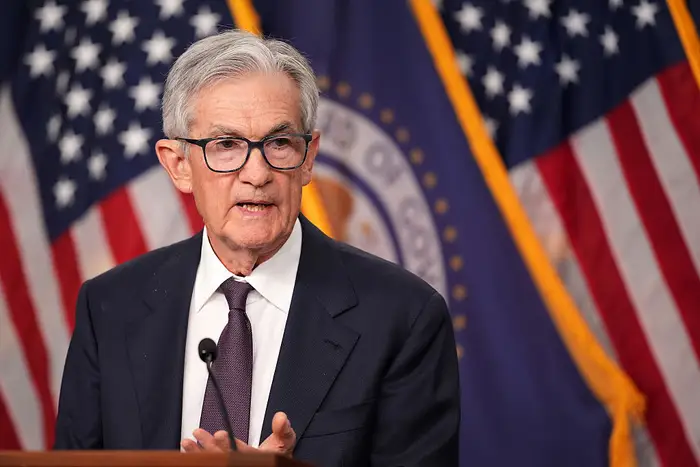US growth is slowing, inflation is sticky, and the Fed is on pause. While India stays resilient, the ripple effect may hit stocks and capital flows harder than expected.
In a closely watched decision, the U.S. Federal Reserve on June 18 left its benchmark interest rate unchanged at 4.25%–4.50%, as expected. But what drew the market’s attention wasn’t the status quo—it was the Fed’s sharply downgraded growth forecasts and its upward revision of inflation expectations, raising fresh fears that the world’s largest economy may be entering a period of stagflation. This uneasy combination of slowing growth and rising prices could create ripple effects across global financial markets, especially in emerging economies like India.
Fed Flags Trouble: Slower Growth, Rising Inflation
The U.S. Federal Reserve, in its June 18 policy meeting, held rates steady at 4.25%–4.50%, but revised its outlook for 2025 sharply downward. GDP is now projected to grow at just 1.4% in 2025, compared to 1.7% forecasted in March. Unemployment is expected to rise to 4.5%, up from the current 4%. Inflation is forecast at 3%, up from the latest 2.8% CPI reading in May.
Fed Chair Jerome Powell flagged that inflation could accelerate through summer, largely due to the delayed pass-through from President Donald Trump’s April 2 tariff wave, dubbed “Liberation Day.” While May CPI surprised to the downside (+0.1% MoM), experts caution that consumer stockpiling ahead of the tariffs masked the real impact—leaving the Fed little room to pivot dovish.
Moody’s Downgrade, Rising Credit Risks Add Fuel to Fire
The Fed’s stance comes amid growing concern about U.S. fiscal health. Moody’s has downgraded the outlook on U.S. sovereign credit, citing rising deficits and political dysfunction. Credit default swap (CDS) spreads on U.S. Treasuries, an indicator of default risk, are now hovering at levels last seen during the Eurozone crisis, approaching those of Greek and Italian bonds.
This erosion of confidence adds another layer of risk for global investors, many of whom already view U.S. fiscal conditions as unsustainable in the medium term.
Are We Entering Stagflation Territory?
Although the U.S. economy isn’t technically in stagflation, the combination of slowing growth and persistent inflation has created a “stagflation-lite” environment. Revised forecasts of 1.4% growth in 2025 and 1.6% in 2026 signal a gradual slowdown.
Analysts warn that inflationary stickiness, weak wage growth, and geopolitical uncertainty are weighing on sentiment. However, strong labor market data and a still-resilient services sector have prevented a full-blown stagflation scenario, for now.
What It Means for India: Macro Resilience, Market Vulnerability
India’s real economy remains largely insulated. Growth is underpinned by domestic consumption, capex, and credit expansion. India is “largely demand-driven,” reducing the direct fallout from U.S. macro trends.
However, the markets are a different story.
The Fed’s delay in rate cuts is keeping global liquidity tight, causing Foreign Portfolio Investors (FPIs) to turn cautious. Since June 1, FPIs have pulled out ₹18,000 crore from Indian equities, coinciding with a rise in the U.S. 10-year bond yield to 4.42%, up from 4.16% in April.
Dollar Weakness: Will India Benefit This Time?
The Dollar Index (DXY) has fallen by ~5% since early April, typically a positive signal for emerging markets. Yet, the expected inflow into Indian assets hasn’t fully materialized. Analysts say this is due to heightened inflation uncertainty in the U.S., which is altering global asset allocation dynamics.
Still, the depreciating dollar does make Indian equities more attractive to USD-based investors. This trend, combined with India’s index inclusions, market cap growth, and macro stability, could tilt capital flows toward Indian stocks over the medium term.
RBI’s Hands May Be Tied
The RBI, which kept its repo rate unchanged at 6.5%, is unlikely to ease policy soon. While India’s inflation eased to 4.75% in May, any Fed delay further reduces the RBI’s flexibility. It has already shifted from an “accommodative” to a “neutral” stance.
A hawkish Fed and a strong dollar can limit the RBI’s rate-cut window—especially if inflation creeps back into the 5%+ range or if crude oil prices remain sticky.
Also Read: RBI Cuts Repo Rate Amid Global Uncertainty, Shifts To Accommodative Stance
Final Take: No Panic, But Stay Nimble
The U.S. Federal Reserve’s updated projections have reawakened fears of a possible stagflation phase—not quite a crisis, but a cloud over the global outlook. For Indian investors, this means a tug-of-war between domestic tailwinds and external headwinds.
India’s economic engine is still firing on most cylinders, but global capital, currency movements, and central bank coordination will be crucial over the next few quarters.
Until the Fed decisively turns dovish, investors would be wise to stay diversified, avoid overheated sectors, keep risk management tight and Track U.S. data and Fed commentary closely.
The U.S. may not be in crisis—but the tremors it sends out could test India’s resilience, both economically and in the stock market.





